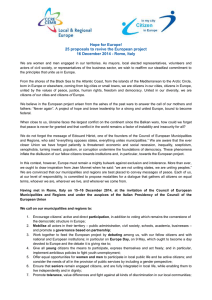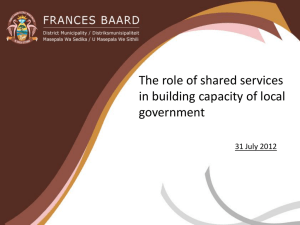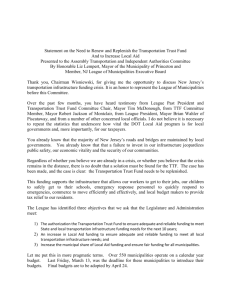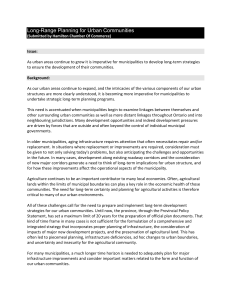TAX INTERACTIONS AMONG BELGIAN
advertisement
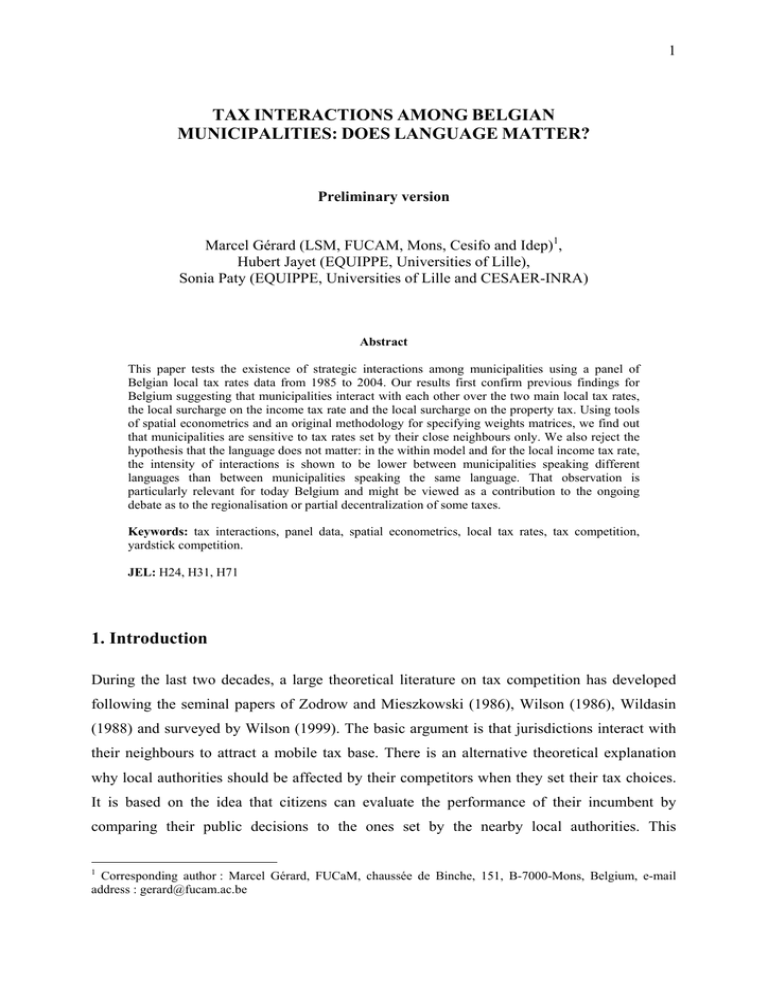
1 TAX INTERACTIONS AMONG BELGIAN MUNICIPALITIES: DOES LANGUAGE MATTER? Preliminary version Marcel Gérard (LSM, FUCAM, Mons, Cesifo and Idep)1, Hubert Jayet (EQUIPPE, Universities of Lille), Sonia Paty (EQUIPPE, Universities of Lille and CESAER-INRA) Abstract This paper tests the existence of strategic interactions among municipalities using a panel of Belgian local tax rates data from 1985 to 2004. Our results first confirm previous findings for Belgium suggesting that municipalities interact with each other over the two main local tax rates, the local surcharge on the income tax rate and the local surcharge on the property tax. Using tools of spatial econometrics and an original methodology for specifying weights matrices, we find out that municipalities are sensitive to tax rates set by their close neighbours only. We also reject the hypothesis that the language does not matter: in the within model and for the local income tax rate, the intensity of interactions is shown to be lower between municipalities speaking different languages than between municipalities speaking the same language. That observation is particularly relevant for today Belgium and might be viewed as a contribution to the ongoing debate as to the regionalisation or partial decentralization of some taxes. Keywords: tax interactions, panel data, spatial econometrics, local tax rates, tax competition, yardstick competition. JEL: H24, H31, H71 1. Introduction During the last two decades, a large theoretical literature on tax competition has developed following the seminal papers of Zodrow and Mieszkowski (1986), Wilson (1986), Wildasin (1988) and surveyed by Wilson (1999). The basic argument is that jurisdictions interact with their neighbours to attract a mobile tax base. There is an alternative theoretical explanation why local authorities should be affected by their competitors when they set their tax choices. It is based on the idea that citizens can evaluate the performance of their incumbent by comparing their public decisions to the ones set by the nearby local authorities. This 1 Corresponding author : Marcel Gérard, FUCaM, chaussée de Binche, 151, B-7000-Mons, Belgium, e-mail address : gerard@fucam.ac.be theoretical literature on "yardstick competition" has been developed a.o. by Salmon (1987) and Besley and Case (1995ab). Although theoretical literature on strategic interactions is quite voluminous, empirical studies are quite recent. Most papers concentrate on tax interactions among local jurisdictions within a country or among states within a federal country (see Brueckner, 2003, for a survey). These models are usually implemented empirically by means of estimation of a fiscal reaction function, where the optimal tax rate in a jurisdiction depends on the tax rates in nearby jurisdictions (Revelli, 2005). Most papers including those of Ladd (1992), Case (1993), Brett and Pinske (2000), Buettner (2001), Heyndels and Vuchelen (1998), Brueckner (1996), Brueckner and Saavedra (2001), Richard, Tulkens and Verdonck (2002), Feld and Reulier (2002), Feld, Josselin and Rocaboy (2003), Bordignon, Cerniglia and Revelli (2003), SoléOllé (2003), Leprince, Madiès et Paty (2007), Charlot et Paty (2007) find empirical evidence of positive interactions among sub-national governments using various data sets. Our paper is mainly in line with this strand of literature by using a panel of Belgian local tax rates data from 1985 to 2004. Our contribution is twofold. First, we find that Belgian municipalities interact with each other on the two main local tax rates, the local surcharge on the income tax and the local surcharge on the property tax. That first result is consistent with the results obtained by previous studies, especially Heyndels and Vuchelen (1998), which proposes a cross section analysis, and Richard, Tulkens and Verdonck (2002), which, on the same period, uses a dynamic model where the slope of the reaction function is not directly estimated. Using tools of spatial econometrics and an original methodology for specifying weights matrices, we find out that municipalities are sensitive to tax rates set by their close neighbours only. Second, we explore the effects of the proximity in terms of language on the empirical evidence of tax interdependence. Then, we reject the hypothesis that the language does not matter for interactions among nearby jurisdictions. Especially, for the local income tax rate, in the within model, the intensity of interactions is shown to be lower between municipalities speaking different languages than between municipalities speaking the same language – the three languages spoken in Belgium are Dutch, French and German. That observation is [Tapez un texte] particularly relevant for today Belgium and might be viewed as a contribution to the ongoing debate as to the regionalisation of some taxes. That reflects the observation that residents’ location choice is influenced by the language spoken in the municipality. A Belgian citizen usually prefers living in a municipality where the residents speak his own language, in order to avoid costs induced by the unavailability of schools, sport and cultural facilities in his own language, or by the need to translate official document received in another language. A policy-maker who fears the mobility of its tax base (the residents) will thus pay more attention to the fiscal choices of the nearby municipalities that share the same language. Moreover, an incumbent who does not fear the residents’ mobility but wants to be re-elected is likely to take as a yardstick the fiscal choices of the nearby municipalities that share the same language because the access to information on fiscal conditions is supposed to be easier between such municipalities – e.g. Belgian newspapers, as to national news, are rather focused on their own language community. Nevertheless citizens are more likely to get information as to the efficiency of neighbouring municipalities belonging to another language community than to actually move to those municipalities. Using spatial econometrics and an original methodology for specifying weights matrices, we find that municipalities are sensitive to tax rates set by their close neighbours only. The paper is organized as follows. The next section presents the empirical design. The results are shown in section 3 and the last section concludes. 2. Empirical Design In this section we provide some useful information as to Belgium before discussing the specification of our model and presenting the data set that we use. 2.1. Belgium, municipalities and local taxation Belgium is a multilevel government country2, a federation consisting of three regions and three communities. Regions – Flanders, Wallonia and Brussels – are basically in charge of matters related to the territory, like economic development, employment policy, infrastructure and the supervision of municipalities. Communities – the Dutch, French and German2 For details see e.g. Gérard (2002). [Tapez un texte] speaking communities – are responsible for issues related to persons, like education and health. Each region and each community has its own government and parliament though Flanders and the Dutch-speaking communities have been merged. According to the Constitution, the residual power belongs to the regions and communities. Even if they are not competent for territorial matters, the authority of communities corresponds to a territory, that of the Dutch-speaking to Flanders and Brussels, and that of the French-speaking one to Wallonia and Brussels as well; the authority of the small German-speaking community is on a series of municipalities attributed to Belgium after the first world war and located in Wallonia. In today Belgium, the corporate income tax and the value added tax are only federal; the personal income tax is mainly federal, but regions are permitted to add positive or negative surcharges, and municipalities as well – see below; the immovable property tax goes to the regions which decide of its rate but municipalities adds surcharges. Regions are mainly financed by transfers from the federal government and by regional taxes as well, while communities are essentially financed by transfers. Belgium also consists of ten provinces and 589 municipalities. In the sequel of the paper we focus on municipalities. Their major expenditure categories include culture and education, police, welfare and transport infrastructure. They levy around 20 different local taxes so that taxation accounts for more than 40% of local revenues (Heyndels and Vuchelen, 1998). The remaining comes from transfers from the regional authorities. However, two taxes, the local income tax and the local property tax, are their major sources of revenue, each accounting for around 40% of municipal tax revenues. Both local taxes are surcharges freely determined by municipalities: - the local income tax is a surcharge on the federal income tax paid by individuals, the rate of the surcharge is between 0 and 10 per cent; in practice this is a tax on labour income, - the local property tax is a surcharge on the regional property tax; its base, also defined at federal level, is an imputed income on immovable property; that tax is paid by all the taxpayers – individuals, companies, charities… – on the basis of the location of the property. [Tapez un texte] Notice that the regional property tax amounts to 1.25 per cent in Brussels and the Walloon Region, and to 2.5 per cent in the Flemish Region, of the imputed income on immovable property; the local surcharge varies between 293.75 and 5,750 per cent of the regional tax. It is important to say that the location of the property determines the place where the tax is to be paid; as an illustration, an individual resident of municipality A which owns a real property in municipality B will pay the local income tax on his labour income in municipality A but the local property tax in municipality B. This explains why, on the sea side, two municipal council elected by resident taxpayers have decided for a zero local income tax rate, charging the burden of local tax revenue on the property tax paid by non-resident owners, or users, of the houses and flats. Each municipality has thus a council elected every six years by residents who vote on lists of candidates presented either by political properties – those also active at regional and federal level – or by local groups, e.g. “list of the mayor”, usually affiliated with one or some of the parties; each list has municipal counsellors in proportion to the number of votes obtained. Then a majority contract is passed within the municipal council; on that base the mayor is designated by the Region and his deputies, in charge of specific fields like finance, education, culture… are elected by the council. The mayor and his deputies form the municipal college, the executive of the municipality. Finally, the main factors of mobility within Belgium are the location of the workplace, though many Belgian residents commute a lot for reaching their workplace, and the price and size of grounds and houses. The residents’ localisation choice is also influenced by the language spoken in the municipality. A Belgian citizen prefers to live in a municipality where the residents speak his language to avoid the costs induced by the use of another language (such as the administrative documents translations, costs of culture access etc.). 2.2. Empirical specification 2.2.1. The econometric model Our aim is to test the existence of strategic interactions among municipalities and to find the effect of linguistic proximity on this interdependence. Both theoretical models of tax and yardstick competition have the same empirical predictions that jurisdiction i fiscal decisions [Tapez un texte] in year t ( τ i,t ) depends on i's own neighbours’ corresponding fiscal decisions ( τ j,t ) and on i's own socio-demographic characteristics ( X i,t ) such as τ i,t = τ(τ j,t , X i,t ) Using a linear formulation, we obtain the following model τ i,t = α + ∑ wi, j (ρ )τ j,t + X i,t β + ηi + εi,t (1) where, for every i, wi ,1 (ρ ),..., wi,I (ρ ) are the coefficients of a matrix of spatial weights, W(ρ), which depends upon a vector of parameters measuring the intensity of interaction, ρ; moreover, W(0) = 0. The term ηi is a municipal effect, taking account of the impact of all the unknown time-invariant factors influencing the tax rates; without loss of generality, we add the identification condition ∑η = 0 . i Model (1) is a spatial panel data model with a spatially lagged dependent variable3. There are three possibilities for estimating this type of model. The first one is to consider that the municipal effects, ηi , are fixed coefficients to be estimated jointly with β and the vector of spatial autoregression coefficients, ρ. On theoretical grounds, this strategy may be accepted. Municipalities are fixed entities so that a larger sample is a sample with the same municipalities but additional periods; therefore, the set of coefficients to be estimated does not vary with the sample size, ensuring consistency. However, estimating the whole set of coefficients of this fixed effects model implies estimating 600 coefficients and may raise computational problems. Alternatives strategies are to estimate a transformed model, using either the between municipalities or the within municipalities transformation. These transformations come from the following decomposition of every variable y yit = yi + ( yit − yi ) 3 This type of model is not very well documented in the spatial econometrics literature; see, however, Elhorst, 2003 and Anselin, Jayet and Le Gallo, 2007. [Tapez un texte] Where, for every municipality i, yi = T −1 ∑ yi,t is the mean over all periods and ( yit − yi ) is the deviation to the municipal mean at period t. The between municipalities transformation uses the first term of this decomposition, the municipal mean, leading to the estimation of the following model τ i = α + ∑ wi, j (ρ )τ j + X i β + (ηi + εi ) (2) The standard assumption that the municipal effects, ηi , are i.i.d. with variance σ η2 and are not correlated with the random terms, εi,t , also deemed to be i.i.d. with variance σ ε2 , implies that the random part of the between municipalities model, ηi + εi , is also i.i.d with variance σ 2 = σ η2 + T −1σ ε2 . Alternatively, we can assume that the vector η = (η1 ,..., ηI )' is spatially autoregressive η = W (λ )η + ζ ⇔ η = (I − W (λ )) ζ −1 where ζ is a vector of i.i.d. random terms. In both cases, the between municipalities model can be estimated using standard maximum likelihood methods. The standard within municipalities transformation uses the second term of the decomposition, the deviation from the mean, leading to the estimation of the following model τ i,t − τ i = ∑ wi, j (ρ )(τ j,t − τ j )+ (X i,t − X i )β + (εi,t − εi ) (3) The advantage of the within municipalities transformation is that the municipal effects ηi disappear. It is well known that, when there is no spatial lag (ρ = 0), this model can be efficiently estimated using ordinary least squares. However, as noted by Anselin, Jayet and Le Gallo (2007), as soon as there is a spatially lagged endogenous variable, the standard within model can no longer be estimated by maximum likelihood. The reason is very simple: the residual terms are linked to each other by the equalities variance-covariance matrix is not full rank. [Tapez un texte] ∑ (ε i,t − εi ) = 0 for all i, and then the We overcome this problem using a variant of the within municipalities transformation where, instead of using deviations from the mean, we use deviations to a reference year. Observations for that year are then deleted from the sample. For example, if the reference year is year 1, this variant of the within municipalities transformation is τ i,t − τi ,1 = ∑ wi, j ( ρ ) ( τ j,t − τ j ,1 ) + ( X i,t − X i ,1 ) β + ( εi,t − εi ,1 ) (3’) In model (3’), the variance-covariance matrix is full rank and the model can be estimated by maximum likelihood. Moreover, we were able to prove that4 • The ML estimators of ρ and β does not depend upon the reference year. • If ρ = 0, the ML (and GLS) estimator of β is the standard OLS estimate on (3). 2.2.2. Specifying the weights matrix The weights matrix, W(ρ), is the matrix with current element wi, j (ρ ) . The line i of W is the set of weights used for calculating the spatial lag of municipality i. Usually, the weights matrix is assumed to be linear, W(ρ) = ρW, where W is row normalised, each row summing to unity. The standard practice is to arbitrarily choose a specific weights matrix on empirical grounds. Standard choices are row normalised contiguity matrices, matrices where only the k nearest neighbours have a positive weight, or weights inversely proportional to distance or to the square of the distance. The fact that the weights matrix is arbitrarily chosen is unsatisfactory, as different matrices may lead to different results. Therefore, some authors test several matrices, in order to assess the robustness of the conclusions. But, in most cases, only one matrix is used. In this paper, we propose a method allowing us to choose a weights matrix within a family of candidates. More precisely, let us consider a set of matrices, W1,… WK where each matrix corresponds to a specific type of interaction between municipalities. The weights matrix used in models (1) to (3) is a linear combination of the initial matrices: W (ρ ) = ρ1W 1 +"+ ρ K W K 4 Proofs are available on request from the authors [Tapez un texte] (4) where the coefficients ρ1,…, ρK are estimated by maximum likelihood, jointly with the other parameters of the model. Estimation programs have been specifically developed for this estimation. This specification of the weights matrix has been used twice. In a first stage, we used it to test the maximum distance separating two interacting municipalities. More precisely, for every municipality i, we sort all the other municipalities by increasing distance. Then, we build pseudo-contiguity matrices C1, …, C9, such that cik, j = 1 if, after sorting by increasing distance to municipality i, municipality j has a rank, or order, between a minimum n−k and a maximum n+k , with Order n−k n+k 1 2 3 4 5 6 7 8 9 1 11 25 45 73 113 169 249 361 10 24 44 72 112 168 248 360 520 The choices of these thresholds implies that the number of nonzero elements of Ck is roughly proportional to the square root of k, so that the distance covered by each matrix are roughly similar. Then, for every k, Wk is obtained after a row normalisation of Ck. 2.2.3. Does language matter? In a second stage, we use a similar methodology for testing whether language matters for interactions between municipalities. More precisely, among the 589 municipalities, there are 335 Flemish-speaking municipalities, 235 French-speaking municipalities, ant the 19 municipalities of the Brussels region, where both languages may be used. We test the hypothesis that the intensity of interactions is lower between two municipalities speaking different languages than between two municipalities speaking the same language. For testing that hypothesis, for every k, we write Wk as the sum of 5 sub-matrices [Tapez un texte] W k = W k , FF + W k ,WW + W k , BB + W k , FW + W k , FB (5) where • wik, ,jFF = wik, j when both municipalities i and j are Flemish, zero otherwise, • wik, ,jWW = wik, j when both municipalities i and j are Walloon, zero otherwise, • wik, ,jBB = wik, j when both i and j are in the Brussels region, zero otherwise, • wik, ,jFW = wik, j when i is Flemish (resp. Walloon) and j is Walloon (resp. Flemish), zero otherwise, • wik, ,jFB = wik, j when i is Flemish (resp. in the Brussels region) and j is in the Brussels (resp. Flemish), zero otherwise, To sum up, W k , FF , W k ,WW and W k , BB , correspond to interactions within the same region, respectively Flanders, Wallonia and Brussels; while W k , FW and W k , BW correspond to interactions between Flanders and the other two regions, Wallonia and Brussels respectively5. Therefore, the full weights matrix takes the following form W (ρ ) = ∑ (ρ k , FF W k , FF + ρ k ,WW W k ,WW + ρ k , BBW k , BB + ρ k , FW W k ,FW + ρ k , FBW k , FB ) k 2.3. Data set We estimate model in equations (1), (2) and (3) using annual data on the 589 Belgian municipalities over the period 1985-2004. These data have been collected by Richard, Tulkens and Verdonck (2002) and by Van Parys and Verbecke (2006). The main data sources are the National Institute of Statistics, the Department of Economics and the Department of Geography of the Université Catholique de Louvain, UCL, in Louvain-la-Neuve. Table 2 reports the summary statistics. As noted above, local tax policies also reflect the impact of differences in economic and demographic factors grouped in the vector X in equation (1). Following the empirical 5 Note that we do not include any interaction between the Brussels regions and Walloon municipalities. This is a consequence of the fact that the Brussels region is completely surrounded by Flemish municipalities and then, within the range of distance where there are significant effects, there are no Walloon municipalities close to the Brussels region [Tapez un texte] literature, we include a set of socio-demographic variables, such as the unemployment rate, the population density and the income per capita. These three variables may be interpreted as expenditure needs variables. We thus expect a positive sign for the respective corresponding parameters. We also include three electoral dummies to check the existence of an electoral cycle, i.e. lower tax rates the years around the election year and higher tax rates in the middle of the legislative period, which last for six years. Finally we include a trend variable. Table 1 displays standard summary statistics for the two explained variables and the three main explanatory variables. Table 2 provides a decomposition of the variance of these variables using the two dimensions introduced above, within and between municipalities. For the local income tax, the local property tax, and the unemployment rate, differences across municipalities are the main source of variability; differences across periods also exist, but they are a minor source of variability. Table 1 - Summary statistics Variable Mean Standard dev. Min Local income tax 6.84 1.07 0 Local property tax 2633.51 689,67 293.75 Pop. Density 6.71 17.42 0.19 Income p.c. 350.45 101.92 147 Unemployment r. 3.60 1.85 0 Note: Number of observations: 11780 (T=20, N=589) Table 2 - Variance disaggregation Within Between Max 10 5750 201.96 704.86 21.51 Variable Total variance within in % of variance Local income tax 0.0451 0.011 0.0342 24.3 Local property tax 0.0859 0.0264 0.0595 30.7 Population density 1.37 0.002 1.37 0.1 Income per capita 0.084 0.065 0.019 77.4 Unemployment rate 0.274 0.065 0.208 23.9 3. Results Both the within and the between transformed models have been estimated using the weights matrices presented in section 2.2. Estimations have been carried out using maximum likelihood. Because the structure of the weights matrix may be quite complex, we systematically tested for the inclusion of coefficients, using a top to the bottom approach: [Tapez un texte] interaction effects between municipalities were not included when, after a Wald test, the hypothesis of a zero coefficient has been accepted. For both the within and the between model, we started with a general specification where spatially autoregressive effects are included for both the endogenous variable and the error term. We estimated the model in two stages. In the first stage, using formula (4), we took into account distances between municipalities without any distinction between regions; the results are summarized in Table 3. In the second stage, we use the results of the first stage as well as equation (5) to investigate the differences across regions; results are then reported in Table 4. Finally, we examine the impact of control variables, like population density, unemployment rate and income per capita, as well as the direction of the trend – see Table 5 and Table 6 in Appendix. 3.1. Without interregional differences Those results have several interesting implications. First of all, there is a striking difference between the estimation results of the within model and the between model. The within model confirms the existence of strategic interactions across municipalities, the coefficients of the autoregressive terms for the endogenous variable being highly significant. The between model suggests the opposite conclusion: no autoregressive term for the endogenous variable has a significant effect so that there is no interaction across municipalities. The second implication is that, for the within model, interactions are limited to municipalities which are close to each other. Given that there are 589 municipalities in Belgium, each Belgian municipality interacts with around its ten per cent closest neighbours. [Tapez un texte] Interaction matrix Rank Table 3 - Autoregressive effects and proximity W1 W2 W3 1-10 11-24 25-44 Endogenous 0.359*** 0.090*** 0.062* Local Income Tax variable (LIT) Error Term Within model Endogenous 0.142** 0.283*** 0.118*** Local Property Tax variable (LPT) Error Term 0.185*** Endogenous Local Income Tax variable (LIT) Error Term 0.300*** Between model Endogenous Local Property Tax variable (LPT) Error Term 0.361*** 0.408*** Notes: Coefficients not significantly differ from zero at the 5% level have been omitted. *: 10% significant, **: 5% significant, ***: 1% significant. W4 45-72 0.087** Tough the within model copes with year to year evolution for each municipality, the between model focuses on differences from the mean, across municipalities and over the whole twenty year period. The absence of interactions between municipalities in that latter model implies that the mean tax level of a municipality is not influenced by the mean tax level of its neighbours. However, the fact that there are significantly positive interactions in the within model implies that municipalities react to tax changes decided by their neighbours: if next door municipality j decreases its tax rate, municipality i also decreases its own rate. 3.2. The role of interregional differences, or languages matter In the second stage, we use the results of the first stage as well as equation (5) to investigate the differences across regions. That analysis is carried out for the within model only and the results are displayed in Table 4. Since there are no interactions between municipalities in the within model, there is no need to analyse how these interactions vary across regions. Our main result shows that there are significant differences between the three regions. For the local income tax, the interaction of a municipality with its closest neighbours is much higher in Brussels and Wallonia than in Flanders. The elasticity of the local income tax rate to the average rate over its closest neighbours amounts to 0.5 in Brussels and Wallonia, while it is only 0.2 in Flanders. For the local property tax, interactions are not significant in Wallonia. For both Brussels and Flanders, the elasticity of the local property tax from the average rate on the closest neighbours is 0.2. [Tapez un texte] Another important result comes from the comparison of the interactions between municipalities located in the same region and the interactions between municipalities located in different regions. For the local income tax, the interactions between Flemish municipalities and municipalities located in the other regions are significantly weaker than the interactions between municipalities located in the same region. This difference does not hold for the local property tax. Table 4 - Interactions between municipalities: interregional differences Type of interaction Within Flanders Proximity rank 1-10 1-10 W 1, FF W 1, FF + W 2,FF W 3, FF W 1,WW W 1,WW + W 2,WW W 1, BB W 1,BB + W 2, BB W 1, FB + W 1, FW 45-72 W4 1-24 25-44 Within Wallonia Within Brussels Between Flanders and the other two regions6 All regions Matrix 1-10 1-24 1-10 1-24 Local Income Tax (LIT) 0.201*** Local Property Tax (LPT) 0.221*** 0.234*** 0.496*** 0.168*** 0.522*** 0.213** 0.171*** 0.211*** 0.121*** 0.164*** Notes: Coefficients not significantly differ from zero at the 5% level have been omitted. *: 10% significant, **: 5% significant, ***: 1% significant. 3.3. The impact of control variables and the direction of the trend Finally, Table 5 shows the estimation results for the four models, i.e. with the local income tax and the local property tax as endogenous variables and using the within and the between transformations, with spatial dependence. Table 6, in appendix, shows the same results when there is no spatial dependence. Differences between the two sets of estimations are not important. We obtain the expected positive sign for the population density but, in most cases, it is not significant. As for the unemployment rate, apart for the within estimator on the local property 6 There is no significant difference between Brussels and Wallonia for that is of their interactions with Flanders. We did not introduce interactions between Wallonia and Brussels because, Brussels being entirely surrounded by Flemish municipalities, there is no close Walloon neighbour to the Brussels Region. [Tapez un texte] tax, we get a positive sign highlighting the fact that unemployed people call for some extra local expenditure – in Belgium part of the initiatives against unemployment are under the responsibility of the municipalities, like the local agencies for employment – that might increase local income taxation. The parameter associated with income per capita is positive for both local tax rates in the within model, as in the empirical literature in which the demand for public services is very often positively correlated with income. It is however negative in the between model, supporting the view that higher income municipalities can obtain the same amount of revenues with smaller rates. Dummy variables for the year around election yeas seem to support view of an electoral cycle. Finally, we get a negative sign for the trend in the local income tax but a positive sign for the local property tax which is in line with the view of putting the tax burden on the more immobile tax base. Table 5 - ML estimation results of within and between models (with spatial lag dependence) Dependent var. Local Income Tax (LIT) Estimator Within Local Property Tax (LPT) Between Within Between Population density 0.026 (0.795) 0.016* (3.42) 0.022 (0.386) 0.001 (0.00) Income per capita 0.099*** (23.4) −0.265*** (12.5) 0.060** (5.48) −0.331*** (15.2) Unemployment rate 0.016*** (16.9) 0.080*** (12.8) −0.024*** (28.3) 0.196*** (33.1) Election year t-1 −0.011*** (18) −0.013*** (16.1) Election year t −0.017*** (41.6) −0.024*** (53.0) Election year t+1 −0.008*** (10.6) −0.017*** (27.8) Trend −0.002* (3.8) 0.006*** (31.8) Intercept 3.34*** (56.4) 4.92*** (91.8) Initial log likelihood 9780 −693 8221 −795 Final log likelihood 10198 −688 8784 −696 Observations 11191 589 11191 589 Notes: *: 10% significant, **: 5% significant, ***: 1% significant; Wald statistics between brackets; variables are log-transformed (except dummies and trend). [Tapez un texte] 4. Conclusion In this paper, we first show that Belgian municipalities interact with each other over the two main local tax rates, the local surcharge on the on the individual income tax and the local surcharge on the property tax. That first result is consistent with the results obtained by previous studies, especially Heyndels and Vuchelen (1998), which proposes a cross section analysis, and Richard, Tulkens and Verdonck (2002), which, on the same period, uses a dynamic model where the slope of the reaction function is not directly estimated. Using tools of spatial econometrics and an original methodology for specifying weights matrices, we find out that municipalities are sensitive to tax rates set by their close neighbours only. Second, we explore the effects of the proximity in terms of language on the empirical evidence of tax interdependence. Then, we reject the hypothesis that the language does not matter for interactions among nearby jurisdictions. Especially, for the local income tax rate, in the within model, the intensity of interactions is shown to be lower between municipalities speaking different languages than between municipalities speaking the same language. That observation is particularly relevant for today Belgium and might be viewed as a contribution to the ongoing debate as to the regionalisation of some taxes. References Anselin L. (1988), Spatial econometrics: Methods and models, Kluwer Academic Publishers, Dordrecht et al. Anselin and Hudak (1992), Spatial econometrics in practice: a review of software options, Regional Science and Urban Economics, 22:-536. Anselin L., Jayet H. and J. Le Gallo (2007) Spatial Econometrics and Panel Data Models, in L. Matyas et P. Sevestre, Handbook of Panel Data Econometrics, Kluwer. Anselin L., Bera K. , Florax R. and Yoon M. (1996), « Simple diagnostic tests for spatial dependence », Regional Science and Urban Economics, 26, pp.77-104. Baltagi, B., ed. (2001), Companion to Theoretical Econometrics, Blackwell Companions to Contemporary Economics, Basil Blackwell, Oxford, U.K. Besley T. and Case A. (1995), « Incumbent behaviour: Vote seeking, tax setting and yardstick competition », American Economic Review, vol. 85(1), pp. 25-45. Bordignon M., Cerniglia F. and Revelli F. (2003), « In search of yardstick competition: A spatial analysis of Italian municipality property tax setting », Journal of Urban Economics, vol. 54, pp. 199217. [Tapez un texte] Brett C. and Pinske J. (2000), « The determinants of municipal tax rates in British Columbia », Canadian Journal of Economics, vol. 33, pp. 695-714. Brueckner J.K. (2003), « Strategic interaction among governments: An overview of empirical studies », International Regional Science Review 26, 175-188. Brueckner J.K. and Saavedra L. (2001), « Do local governments engage in strategic property-tax competition ? », National Tax Journal, vol. 54, pp. 203-229. Buettner T. (2001), « Local business taxation and competition for capital: The choice of the tax rate », Regional Science and Urban Economics, vol. 31, pp. 215-245. Case A.C. (1993), « Interstate tax competition after TRA86 », Journal of Policy Analysis and Management, vol. 12(1), pp. 136-48. Case A.C., Rosen H.S. and Hines J.R. (1993), « Budget spillovers and fiscal policy interdependence: Evidence from the states », Journal of Public Economics, vol. 52, pp. 285-307. Cliff A. and Ord J. (1973), Spatial autocorrelation, London: Pion. Charlot S. and S. Paty (2007), « Market access effect and local tax setting: Evidence from a French panel data », Journal of Economic Geography, 7(3). Elhorst J.P. (2003), "Specification and estimation of spatial panel data models", International Regional Science Review, 26(3), pp. 244-268. Feld L.P, Josselin J.M. and Rocaboy Y. (2002), "Le mimétisme fiscal : une application aux régions françaises", Economie et Prévision, vol. 156(5), pp. 43-49. Feld L.P and Kirchgässner G. (2001), "Income tax competition at the state and local level in Switzerland", Regional Science and Urban Economics, vol. 31, pp. 181-213. Figlio D.N., Kolpin V.W. and Reid W.E. (1999), "Do states play welfare games ?", Journal of Urban Economics, vol. 46, pp. 437-454. Gérard, M., 2002, “Fiscal Federalism in Belgium ”, in Commission on Fiscal Imbalance, A new division of Canada’s Financial Resources Report, Supporting document 3, Québec Provincial Government, pp. 175-194. Heyndels B. and Vuchelen J. (1998), "Tax mimicking among Belgian municipalities", National Tax Journal, vol. 51, pp. 89-101. Kneebone R. and McKenzie K. (2001) "Electoral and Partisan Cycles in Fiscal Policy: an Examination of Canadian Provinces," International Tax and Public Finance, vol. 8, pp. 753-774. Leprince M., Madiès T. and Paty S. (2007), "Business tax interactions among local governments: An empirical analysis of local tax setting in France", Journal of Regional Science, 47(3). Revelli F. (2001), « Spatial patterns in local taxation: Tax mimicking or error mimicking? », Applied Economics, vol. 33, pp. 1101-1107. Revelli F. (2002), « Local taxes, national politics and spatial interactions in English district election results », European Journal of Political Economy, vol. 18, pp. 281-299. Richard J-F, H Tulkens and M Verdonck (2002), “Dynamique des interactions fiscales entre les communes belges 1984-1997”, Economie et prévision, vol. 156, pp. 1-14, 2002. Saavedra L.A. (2000), « A model of welfare competition with evidence from AFDC », Journal of Urban Economics , vol. 47, pp. 248-279. Salmon P. (1987), « Decentralization as an incentive scheme », Oxford Review of Economic Policy, vol. 3, pp. 24-43. Solé-Ollé A. (2003), « Electoral accountability and tax mimicking: the effects of electoral margins, coalition government, and ideology », European Journal of Political Economy, vol. 19(4), pp. 685713. [Tapez un texte] Van Parys and Verbecke (2006), “Tax competition among Belgian Municipalities: a multidimensional battle?”, University of Ghent, mimeo. Wilson J.D. (1999), « Theories of tax competition », National Tax Journal, vol. 52, pp.269-304. Appendix Table 6: OLS estimation results of within and between models without spatial lag dependence. Dependent var. Local Income Tax (LIT) Local Property Tax (LPT) Estimator Within Between Within Between Population density 0 (0) 0.016** (2.36) 0 (0) 0.048*** (5.73) Income p.c. 0.166*** (7.72) -0.247*** (-3.78) 0.207*** (8.4) -0.861*** (-11.1) Unemployment rate 0.033*** (8.2) 0.079*** (4.43) -0.062*** (-13.4) 0.070*** (3.32) Election year t-1 -0.022*** (-8.27) - -0.026*** (-8.29) - Election year t -0.036*** (-13.5) - -0.048*** (-15.5) - Election year t+1 -0.018*** (-6.9) - -0.036*** (-11.8) - Trend -0.001* (-1.57) - 0.009*** (8.88) - Intercept - 3.23*** (8.38) - 8.11*** (17.7) Log lik. 9780 -693 8221 -796 Observations 11191 589 11191 589 Notes: *: 10% significant, **: 5% significant, ***: 1% significant. T-statistics in parentheses. Variables are logtransformed (except dummies and trend). [Tapez un texte]
